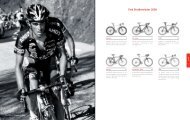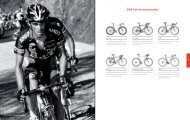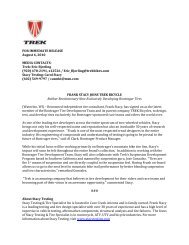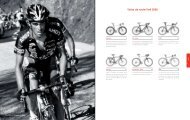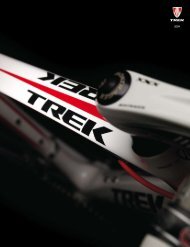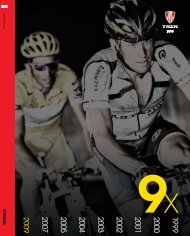Airfoil Development for the Trek Speed Concept ... - Slowtwitch.com
Airfoil Development for the Trek Speed Concept ... - Slowtwitch.com
Airfoil Development for the Trek Speed Concept ... - Slowtwitch.com
You also want an ePaper? Increase the reach of your titles
YUMPU automatically turns print PDFs into web optimized ePapers that Google loves.
<strong>Trek</strong>’s library of airfoil designs and aerodynamic per<strong>for</strong>mance data would eventually grow to include over 80 airfoil designs and 250<br />
individual CFD simulations. Following trends, such as those shown in <strong>the</strong> previous figure, this immense library pointed towards <strong>the</strong><br />
optimum bicycle airfoil designs. In addition, <strong>the</strong> analysis of <strong>the</strong> flow patterns within each CFD simulation revealed exactly why <strong>the</strong>se<br />
airfoils per<strong>for</strong>med so well.<br />
1.3.2 Phase 2<br />
The airfoils developed in phase 1 could have been leveraged to make a bicycle faster than <strong>the</strong> <strong>Trek</strong> TTX, <strong>the</strong> fastest bike <strong>Trek</strong> had ever<br />
tested in <strong>the</strong> wind tunnel. Despite this prospect of success, <strong>the</strong> study was expanded beyond traditional airfoil shapes. Using <strong>Trek</strong>’s<br />
highly-efficient CFD test method, <strong>the</strong>re was very little time penalty <strong>for</strong> exploring wild airfoil ideas. Anything was fair game, and after<br />
three months of exploration, one such wild idea gave a strange result – negative drag! While negative drag is <strong>the</strong>oretically possible<br />
(Appendix 2), it was such an extreme result that <strong>the</strong> engineers didn’t know whe<strong>the</strong>r to celebrate or start looking <strong>for</strong> a mistake in <strong>the</strong><br />
analysis. Of course, <strong>the</strong>re was no mistake, and <strong>the</strong> Kammtail Virtual Foil (KVF) was born.<br />
As was done <strong>for</strong> <strong>the</strong> traditional airfoil library, <strong>the</strong> key geometric parameters of <strong>the</strong> KVF were identified, and <strong>the</strong>ir effects on<br />
aerodynamic drag were studied in CFD. Over <strong>the</strong> next several months, a new library of over 50 KVF geometries and data was built.<br />
During this process, it was observed that <strong>the</strong> aerodynamic per<strong>for</strong>mance of KVF airfoils was significantly improved by even slight<br />
changes in geometry. Fur<strong>the</strong>rmore, <strong>the</strong> pitch orientation of <strong>the</strong> tube heavily dictates <strong>the</strong> relative per<strong>for</strong>mance of different KVF designs.<br />
As a result, <strong>Trek</strong> engineers have taken painstaking steps to fine-tune <strong>the</strong> geometries <strong>for</strong> optimum per<strong>for</strong>mance of each individual<br />
bicycle frame and <strong>for</strong>k tube. By nature, <strong>the</strong> KVF design must be highly-engineered, and casual knowledge of Kamm-style airfoil<br />
construction and <strong>the</strong>ory is not enough to design a high-per<strong>for</strong>ming KVF.<br />
1.3.3 Phase 3<br />
Although no mistakes were identified in <strong>the</strong> ongoing CFD analyses, <strong>the</strong> KVF airfoil results still seemed too good to be true. Be<strong>for</strong>e<br />
designing a bike around <strong>the</strong> KVF airfoil concept, a wind tunnel validation was warranted. In October 2008, <strong>Trek</strong> engineers took <strong>the</strong><br />
opportunity to test at <strong>the</strong> A2 Wind Tunnel <strong>for</strong> <strong>the</strong> first time.<br />
For <strong>the</strong>se tests, <strong>Trek</strong>’s in-house Prototype <strong>Development</strong> Lab CNC-machined <strong>the</strong> top four KVF shapes and <strong>the</strong> TTX down tube shape<br />
into solid aluminum tube sections. Each section was capped at both ends with an identical taper designed to reduce end-effects to a<br />
much smaller and more consistent contribution to <strong>the</strong> overall drag. These sections were tested across a wide range of pitch and yaw<br />
angles . The figure below shows <strong>the</strong> data <strong>for</strong> a vertical pitch angle.<br />
Figure 5: A2 Wind Tunnel data <strong>for</strong> airfoil<br />
sections tested at a vertical pitch angle.<br />
Notes: A2 Wind Tunnel. Tares not removed.<br />
7







